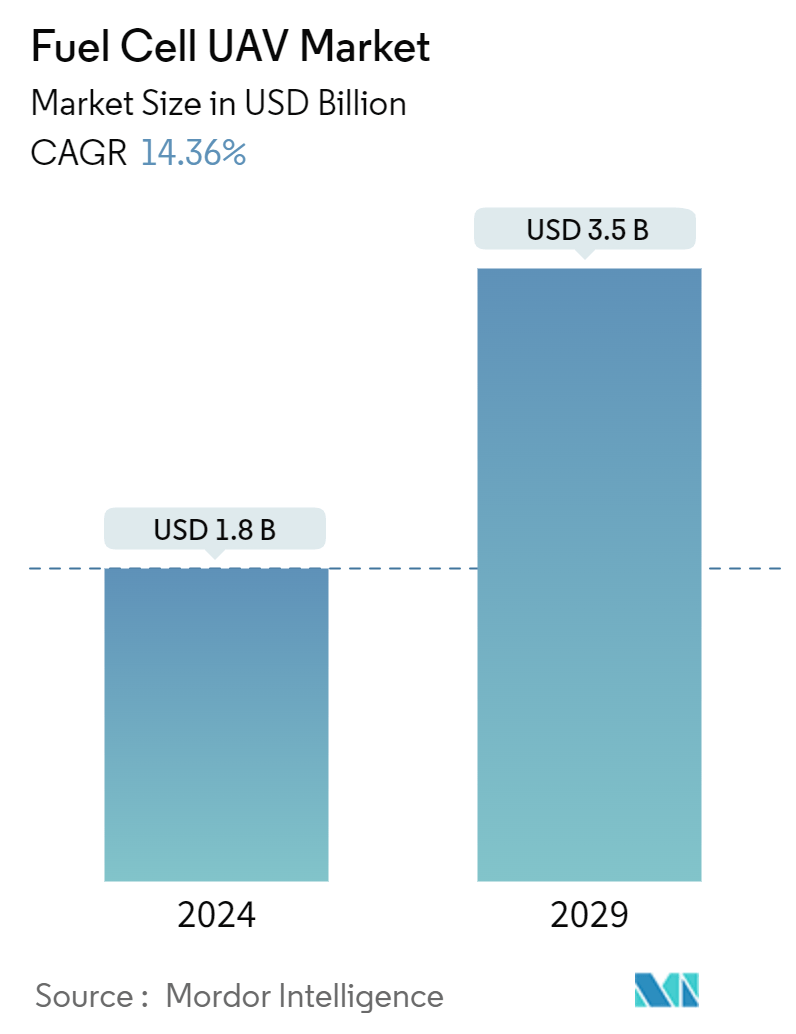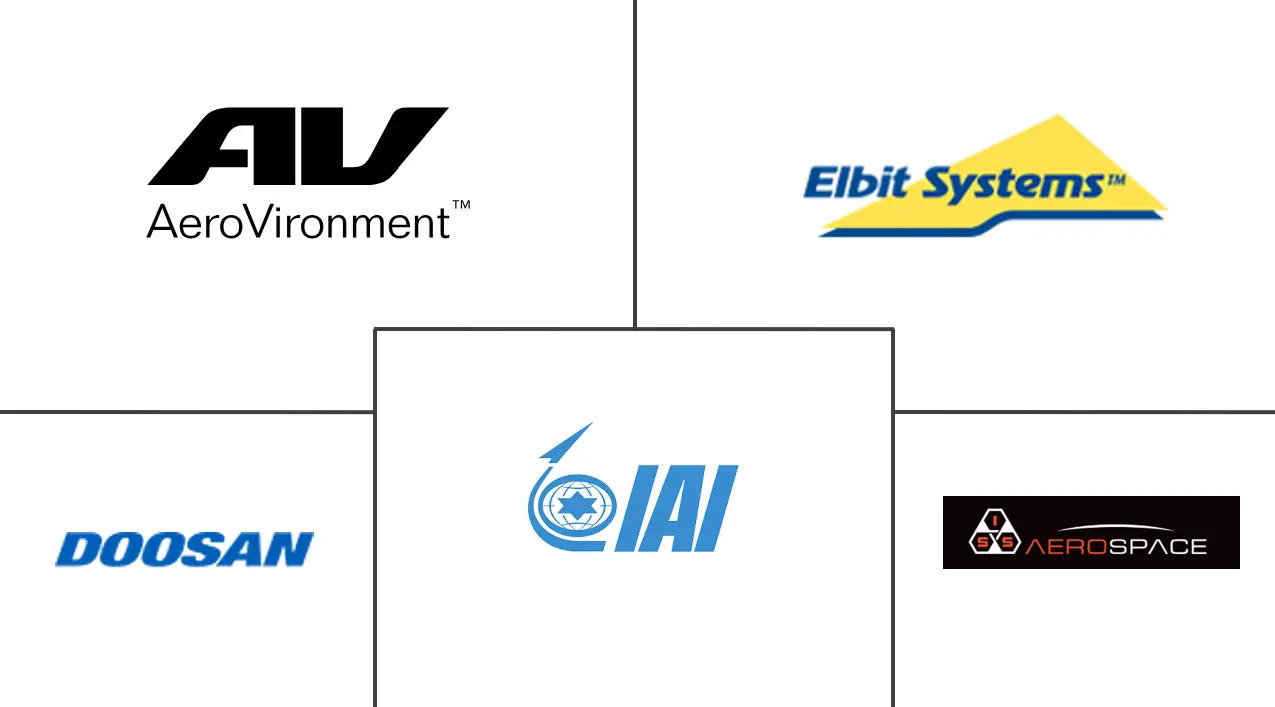Market Size of Fuel Cell UAV Industry

| Study Period | 2019 - 2029 |
| Market Size (2024) | USD 1.8 Billion |
| Market Size (2029) | USD 3.5 Billion |
| CAGR (2024 - 2029) | 14.36 % |
| Fastest Growing Market | Asia Pacific |
| Largest Market | North America |
| Market Concentration | Medium |
Major Players
*Disclaimer: Major Players sorted in no particular order |
Fuel Cell UAV Market Analysis
The Fuel Cell UAV Market size is estimated at USD 1.8 billion in 2024, and is expected to reach USD 3.5 billion by 2029, growing at a CAGR of 14.36% during the forecast period (2024-2029).
The fuel cell UAV market is a transformational segment in the UAV industry, driven by the necessity of extended flight times and reduced environmental impacts. Fuel cell technology offers a compelling alternative to traditional lithium-ion battery technology with its higher energy density and longer endurance. This development addresses the most critical limitations of battery-powered UAVs, which attract fuel cell UAVs to applications with long-duration flights, like surveillance, mapping, and inspection conducted in remote areas.
Key players in the unmanned aerial vehicle (UAV) industry are now developing and integrating the fuel cell system into their UAV platform. This has led to a diversified range of products catering to various industrial needs. The potential of hydrogen fuel cells to deliver continuous and reliable power over prolonged periods is a significant reason behind their adoption, both for commercial and military applications.
The regulatory bodies, including the Federal Aviation Administration (FAA) and the European Union Aviation Safety Agency (EASA), have begun to acknowledge the benefits of fuel cell technology; they have exempted and approved its wide use. These regulation changes have opened new perspectives and areas for adopting fuel cell UAVs in agriculture, infrastructure monitoring, logistics, and military and emergency response. This represents an increase in operational efficiency and a lower carbon footprint, aligning them with global sustainability goals.
Despite the promising outlook, challenges with respect to the fuel cell UAV market include high costs for development, a limited hydrogen refueling infrastructure, and stringent safety regulations. Complex integration of fuel cell systems into the UAVs, in turn, requires strong R&D efforts and expertise. However, continuous development in hydrogen production and storage technologies, with the help of supportive government policies, is expected to overcome such challenges. Therefore, the fuel cell UAV market will experience tremendous growth with continuous technological developments and increasing emphasis on sustainable aviation solutions.
Fuel Cell UAV Industry Segmentation
A fuel-cell propulsion system powers a fuel-cell unmanned aerial vehicle (UAV). A fuel cell is an electrochemical device that generates electricity by combining hydrogen (usually stored in a tank) with oxygen from the air, producing water and releasing energy. This energy is then used to power the UAV's motors and other systems.
The fuel cell UAV market is segmented based on end user and geography. By end user, the market is segmented into commercial and military. The report also covers the market sizes and forecasts for the fuel cell UAV market in major countries across different regions. For each segment, the market size is provided in terms of value (USD).
| End User | |
| Commercial | |
| Military |
| Geography | |||||||
| |||||||
| |||||||
| |||||||
| |||||||
|
Fuel Cell UAV Market Size Summary
The fuel cell UAV market is poised for significant growth, driven by the need for extended flight times and reduced environmental impact. Fuel cell technology presents a superior alternative to traditional lithium-ion batteries, offering higher energy density and longer endurance, which are crucial for applications requiring long-duration flights such as surveillance, mapping, and remote inspections. Key industry players are actively developing and integrating fuel cell systems into UAV platforms, resulting in a diverse range of products tailored to various industrial needs. The adoption of hydrogen fuel cells is further bolstered by regulatory approvals from bodies like the FAA and EASA, which recognize the technology's benefits and have facilitated its use across sectors such as agriculture, infrastructure monitoring, logistics, and military operations. Despite challenges like high development costs and limited hydrogen refueling infrastructure, ongoing advancements in hydrogen production and storage, supported by favorable government policies, are expected to drive market expansion.
The military sector is anticipated to experience substantial growth within the fuel cell UAV market, fueled by increased defense budgets and the demand for advanced UAV systems to support critical missions. Fuel cell UAVs offer advantages such as extended flight endurance, stealth operations, and reduced logistical burdens, making them ideal for military applications. The strategic contracts and technological advancements highlight the military's growing reliance on these systems to enhance operational capabilities. In the Asia-Pacific region, the market is expected to grow rapidly due to rising demand across sectors like agriculture and logistics, alongside government initiatives to bolster UAV capabilities. Major contracts and collaborations, such as those involving Doosan Mobility Innovation and DroneUp LLC, are driving the market forward, with significant investments in R&D aimed at improving fuel cell efficiency and integration with UAV systems. The market is semi-consolidated, with key players focusing on technological innovation, strategic cooperation, and cost efficiency to deliver high-performance, sustainable fuel cell UAV solutions.
Fuel Cell UAV Market Size - Table of Contents
-
1. MARKET DYNAMICS
-
1.1 Market Overview
-
1.2 Market Drivers
-
1.3 Market Restraints
-
1.4 Porter's Five Forces Analysis
-
1.4.1 Bargaining Power of Buyers/Consumers
-
1.4.2 Bargaining Power of Suppliers
-
1.4.3 Threat of New Entrants
-
1.4.4 Threat of Substitute Products
-
1.4.5 Intensity of Competitive Rivalry
-
-
-
2. MARKET SEGMENTATION
-
2.1 End User
-
2.1.1 Commercial
-
2.1.2 Military
-
-
2.2 Geography
-
2.2.1 North America
-
2.2.1.1 United States
-
2.2.1.2 Canada
-
-
2.2.2 Europe
-
2.2.2.1 United Kingdom
-
2.2.2.2 France
-
2.2.2.3 Germany
-
2.2.2.4 Rest of Europe
-
-
2.2.3 Asia-Pacific
-
2.2.3.1 China
-
2.2.3.2 Japan
-
2.2.3.3 India
-
2.2.3.4 South Korea
-
2.2.3.5 Rest of Asia-Pacific
-
-
2.2.4 Latin America
-
2.2.4.1 Brazil
-
2.2.4.2 Mexico
-
2.2.4.3 Rest of Latin America
-
-
2.2.5 Middle East and Africa
-
2.2.5.1 United Arab Emirates
-
2.2.5.2 Saudi Arabia
-
2.2.5.3 Qatar
-
2.2.5.4 Rest of Middle East and Africa
-
-
-
Fuel Cell UAV Market Size FAQs
How big is the Fuel Cell UAV Market?
The Fuel Cell UAV Market size is expected to reach USD 1.8 billion in 2024 and grow at a CAGR of 14.36% to reach USD 3.5 billion by 2029.
What is the current Fuel Cell UAV Market size?
In 2024, the Fuel Cell UAV Market size is expected to reach USD 1.8 billion.

